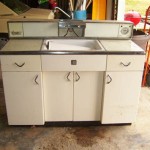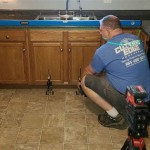How to Remove Stain from Kitchen Cabinets Without Sanding
Kitchen cabinets are prone to wear and tear, especially with heavy daily use. Stains can accumulate on their surfaces due to spills, food splatters, or simply the passage of time. While sanding is a common method for removing stains, it can be a messy and time-consuming process, requiring specialized tools and expertise. Fortunately, there are several effective ways to eliminate stains from your kitchen cabinets without resorting to sanding.
1. Using Cleaning Solutions
The first line of defense against stubborn stains on kitchen cabinets is a combination of cleaning solutions. This approach is particularly effective for stains caused by spills or food splatters. The key is to use a gentle yet effective cleaning agent that won't damage the cabinet’s finish.
Here's a step-by-step guide:
- Prepare the area: Clean the stained area thoroughly with a damp cloth and mild dish soap. This removes surface dirt and grease that might hinder the cleaning process.
- Apply a cleaning solution: Depending on the stain's nature, you can use a variety of cleaning solutions:
*
For grease and oil stains:
A mixture of baking soda and water forms a paste that can effectively lift grease and oil. *For water marks and discoloration:
A solution of white vinegar and water can help remove water marks and brighten the surface. *For ink stains:
Rubbing alcohol can be used to effectively remove ink stains. - Scrub gently: Use a soft-bristled brush or a non-abrasive sponge to gently scrub the stained area. Avoid using harsh scrubbing pads or abrasive materials that can scratch the cabinet surface.
- Wipe clean: Once the cleaning solution has been applied and scrubbed, wipe the area clean with a damp cloth.
- Dry thoroughly: Dry the cleaned area with a clean, dry cloth. Leaving moisture behind can contribute to further discoloration or damage.
If the stain persists after using cleaning solutions, you can move on to alternative methods.
2. Using a Magic Eraser
A magic eraser is a versatile cleaning tool that can effectively remove stains from a variety of surfaces, including kitchen cabinets. It is made of melamine foam, a synthetic material that acts like fine sandpaper, gently removing the top layer of the stained area. The magic eraser's effectiveness lies in its ability to remove the stain without damaging the cabinet's finish, especially when used carefully.
Here's how to use a magic eraser on your cabinets:
- Dampen the eraser: Lightly dampen the magic eraser with water. It should be moist but not dripping wet.
- Gently rub the stain: Use a gentle back-and-forth motion to rub the stained area. Don't press too hard as this can cause scratches.
- Wipe clean: Once the stain has been removed, wipe the area clean with a damp cloth.
- Dry thoroughly: Ensure the area is completely dry to avoid further damage or discoloration.
While magic erasers are generally safe for use on kitchen cabinets, it's always a good idea to test it on an inconspicuous area first to ensure compatibility with your cabinet's finish.
3. Using a Furniture Polishing Cream
If cleaning solutions and a magic eraser don't fully remove the stain, you can try using a furniture polishing cream. This method can work effectively on stains caused by scratches or minor abrasions. It works by gently smoothing the surface of the cabinet, effectively hiding the stain and restoring its shine.
Here's how to apply a furniture polishing cream:
- Prepare the surface: Clean the stained area with a damp cloth and mild dish soap to remove any dirt or grime.
- Apply a small amount of cream: Apply a small amount of furniture polishing cream to a soft cloth.
- Rub the cream in: Gently rub the cream into the stained area using circular motions.
- Buff the area: After applying the cream, use a clean, dry cloth to buff the area until it shines.
Choose a furniture polishing cream specifically designed for the type of finish on your kitchen cabinets. Always test the product on a small, inconspicuous area first before applying it to the entire surface.
Remember to always consult the manufacturer's instructions for the cleaning solutions used on your kitchen cabinets to ensure safe and effective stain removal.

Gel Stain Kitchen Cabinets Without Sanding Fast Easy Diy

How To Remove Stain Without Sanding Confessions Of A Serial Do It Yourselfer

Update Kitchen Cabinets No Sanding

How I Updated My Oak Cabinets Without Paint By Using Briwax Easy Budget Kitchen Makeover Only 24

How To Lighten Stained Wood 7 Options That Work Grace In My Space

How To Re Oak Cabinets No Sanding Or Painting Simply Diy Home

How To Paint Laminate Cabinets Without Sanding The Palette Muse

Refinish Kitchen Cabinets Without Stripping

Staining Your Wood Cabinets Darker Young House Love

Diy Bathroom Cabinets How To Lighten Wood The Dotted Bow
Related Posts








